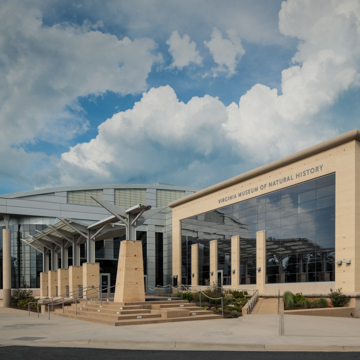Starling Avenue and its adjacent streets were developed as a residential neighborhood in the early twentieth century, but the area is changing fast. This museum of buff-colored brick and tinted glass brought new life to the avenue. From the street five tall, bannered columns create a formal driveway to the museum that is set back behind the parking areas. On reaching the museum, a broad flight of stairs rises to a plaza partially shaded by a butterfly wing–roofed canopy that is carried on a row of concrete and steel piers. The plaza fits in the reentrant angle created by the lobby and the museum's tinted-glass facade. Double doors open to the light-filled forty-foot-high lobby and beyond that to the Great Hall where the exterior columns are repeated with eight more. Exhibit spaces and a theater section occupy the right side of the hall, and on the left there are large open laboratories where the museum's scientists work on view to visitors.
You are here
Virginia Museum of Natural History
If SAH Archipedia has been useful to you, please consider supporting it.
SAH Archipedia tells the story of the United States through its buildings, landscapes, and cities. This freely available resource empowers the public with authoritative knowledge that deepens their understanding and appreciation of the built environment. But the Society of Architectural Historians, which created SAH Archipedia with University of Virginia Press, needs your support to maintain the high-caliber research, writing, photography, cartography, editing, design, and programming that make SAH Archipedia a trusted online resource available to all who value the history of place, heritage tourism, and learning.

